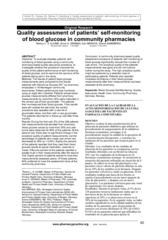Quality assessment of patients’ self-monitoring of blood glucose in community pharmacies
Peer reviewed, Journal article
Published version
Permanent lenke
https://hdl.handle.net/1956/4353Utgivelsesdato
2010Metadata
Vis full innførselSamlinger
Sammendrag
Objective: To evaluate diabetes patients’ selfmonitoring of blood glucose using a community pharmacy-based quality assurance procedure, to investigate whether the procedure improved the quality of the patient performance of self monitoring of blood glucose, and to examine the opinions of the patients taking part in the study. Methods: The results of patient blood glucose measurements were compared to the results obtained with HemoCue Glucose 201+ by pharmacy employees in 16 Norwegian community pharmacies. Patient performance was monitored using an eight item checklist. Patients whose blood glucose measurements differed from pharmacy measurements by more than 20% were instructed in the correct use of their glucometer. The patients then re-measured their blood glucose. If the results were still outside the set limits, the control procedure was repeated with a new lot of glucometer strips, and then with a new glucometer. The patients returned for a follow-up visit after three months. Results: During the first visit, 5% of the 338 patients had measurements that deviated from pharmacy blood glucose values by more than 20% and user errors were observed for 50% of the patients. At the second visit, there was no significant change in the analytical quality of patient measurements, but the percentage of patients who made user errors had decreased to 29% (p < 0.001). Eighty-five percent of the patients reported that they used their blood glucose results to adjust medication, exercise or meals. Fifty-one percent of the patients reported a greater trust in their measurements after the second visit. Eighty percent of patients wished to have their measurements assessed yearly. Of these patients, 83% preferred to have the assessment done at the community pharmacy. Conclusion: A community pharmacy-based quality assessment procedure of patients’ self monitoring of blood glucose significantly reduced the number of user errors. The analytical quality of the patients’ measurements was good and did not improve further during the study. The high analytical quality might be explained by a selection bias of participating patients. Patients also reported increased confidence in their blood glucose measurements after their measurements had been assessed at the pharmacy.
